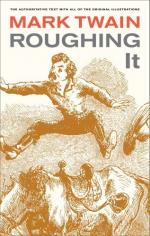We were full of anxiety in a moment. The rock was clean and white, where it was broken, and across it ran a ragged thread of blue. He said that that little thread had silver in it, mixed with base metal, such as lead and antimony, and other rubbish, and that there was a speck or two of gold visible. After a great deal of effort we managed to discern some little fine yellow specks, and judged that a couple of tons of them massed together might make a gold dollar, possibly. We were not jubilant, but Mr. Ballou said there were worse ledges in the world than that. He saved what he called the “richest” piece of the rock, in order to determine its value by the process called the “fire-assay.” Then we named the mine “Monarch of the Mountains” (modesty of nomenclature is not a prominent feature in the mines), and Mr. Ballou wrote out and stuck up the following “notice,” preserving a copy to be entered upon the books in the mining recorder’s office in the town.
“Notice.”
“We the undersigned claim three claims, of three hundred feet each (and one for discovery), on this silver-bearing quartz lead or lode, extending north and south from this notice, with all its dips, spurs, and angles, variations and sinuosities, together with fifty feet of ground on either side for working the same.”
We put our names to it and tried to feel that our fortunes were made. But when we talked the matter all over with Mr. Ballou, we felt depressed and dubious. He said that this surface quartz was not all there was of our mine; but that the wall or ledge of rock called the “Monarch of the Mountains,” extended down hundreds and hundreds of feet into the earth —he illustrated by saying it was like a curb-stone, and maintained a nearly uniform thickness-say twenty feet—away down into the bowels of the earth, and was perfectly distinct from the casing rock on each side of it; and that it kept to itself, and maintained its distinctive character always, no matter how deep it extended into the earth or how far it stretched itself through and across the hills and valleys. He said it might be a mile deep and ten miles long, for all we knew; and that wherever we bored into it above ground or below, we would find gold and silver in it, but no gold or silver in the meaner rock it was cased between. And he said that down in the great depths of the ledge was its richness, and the deeper it went the richer it grew. Therefore, instead of working here on the surface, we must either bore down into the rock with a shaft till we came to where it was rich—say a hundred feet or so —or else we must go down into the valley and bore a long tunnel into the mountain side and tap the ledge far under the earth. To do either was plainly the labor of months; for we could blast and bore only a few feet a day—some five or six. But this was not all. He said that after we got the ore out it must be hauled in wagons to a distant silver-mill, ground up, and the silver extracted by a tedious and costly process. Our fortune seemed a century away!




